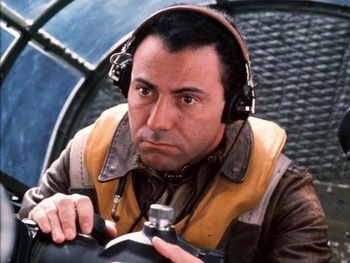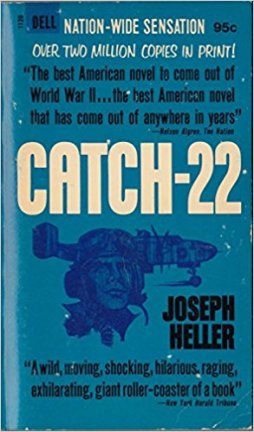
”You mean there’s a catch?”
“Sure there’s a catch,” Doc Daneeka replied. “Catch-22. Anyone who wants to get out of combat duty isn’t really crazy.”
“There was only one catch and that was Catch-22, which specified that a concern for one’s own safety in the face of dangers that were real and immediate was the process of a rational mind. Orr was crazy and could be grounded. All he had to do was ask; and as soon as he did, he would no longer be crazy and would have to fly more missions. Orr would be crazy to fly more missions and sane if he didn’t, but if he was sane, he had to fly them. If he flew them he was crazy and didn’t have to; but if he didn’t want to, he was sane and had to. Yossarian was moved very deeply by the absolute simplicity of this clause of Catch-22 and let out a respectful whistle.”
“That’s some catch, that Catch-22,” he observed.
“It’s the best there is,” Doc Daneeka agreed. (Joseph Heller, Catch-22)
 I first read Catch-22 when I was 19 years old. This was in the late 60’s just before being sent to Vietnam. It was the one book I took with me. Sometime during that deployment, I lost the book, but never its spirit.
I first read Catch-22 when I was 19 years old. This was in the late 60’s just before being sent to Vietnam. It was the one book I took with me. Sometime during that deployment, I lost the book, but never its spirit.
Author Joseph Heller joined the U.S. Army Air Corp in 1942. He was 19 years old. In 1944 Heller found himself in Italy as a B-25 Bombardier. He flew 60 missions. For most of those flights he encountered little or no enemy fighters or anti-aircraft artillery. He later categorized them as “milk runs.” His military experience and background would come to use later in his epic novel. His anti-hero Yossarian was a Bombardier just like him.
The illogical logic of Heller’s brilliant anti-war satire (it’s my favorite novel) exposed the insanity of war. Yossarian (Alan Arkin) is an American Bombardier stationed in Italy. He’s convinced everyone wants him dead, not just the Germans, but his own officers. They keep sending him on dangerous missions! To stop flying these insane missions, his higher ups inform him he needs to complete a certain number of missions. The only problem is when he or any other bombardier come near the magic number of missions needed, his commanding officer raises the number of missions required to be rotated out. Yossarian insists the entire world is crazy including him. And if he is insane, he should not be flying these missions; however, the flight surgeon (Jack Gilford) declares that anyone who understands the insanity of the situation cannot be insane! Subsequently, Yossarian must continue to fly more missions. Like with many things in life, there is no escape.
 Catch-22, the movie, and the book is a surrealistic trip that captures the absurdity of war, and of a bureaucratic society in general, frame for frame, a mix of satire, comedy and tragedy. Though set during World War II the film, released in 1970, captured the spirit of the late 1960’s: the Counterculture, the Vietnam War and the Rock Generation. Heller’s novel, published in 1962 was a progressive masterpiece that only gained in popularity and in cult status as the sixties moved on into the later years of the decade. When it was announced Mike Nichols would direct the film version, it was met with high expectations, so high that it almost guaranteed failure. Critics of the day were split. Roger Ebert called it “a disappointment.” He went on, “the movie is essentially a parasite, depending on the novel for its vitality…” On the other side of the coin, Vincent Canby writing in the New York Times said, Catch-22 “is quite simply, the best American film I’ve seen this year.” Either way, the film died at the box-office.
Catch-22, the movie, and the book is a surrealistic trip that captures the absurdity of war, and of a bureaucratic society in general, frame for frame, a mix of satire, comedy and tragedy. Though set during World War II the film, released in 1970, captured the spirit of the late 1960’s: the Counterculture, the Vietnam War and the Rock Generation. Heller’s novel, published in 1962 was a progressive masterpiece that only gained in popularity and in cult status as the sixties moved on into the later years of the decade. When it was announced Mike Nichols would direct the film version, it was met with high expectations, so high that it almost guaranteed failure. Critics of the day were split. Roger Ebert called it “a disappointment.” He went on, “the movie is essentially a parasite, depending on the novel for its vitality…” On the other side of the coin, Vincent Canby writing in the New York Times said, Catch-22 “is quite simply, the best American film I’ve seen this year.” Either way, the film died at the box-office.
The film captures the anti-war message that was popular at the time and manages to convey the insanity of war, the hopelessness of the soldiers caught in the middle and the narrow-minded vision of the military mentality and its mindless gun-ho patriotic fever.
There was another anti-war film released that same year, Robert Altman’s M.A.S.H. a film that was met with more of a universal reception and was a big hit. Though set during the Korean War, like Catch-22, it echoed Vietnam and its times.
Buck Henry who worked with Nichols on The Graduate was given the impossible task of adapting Heller’s novel to the screen, and many of the scenes are set-pieces. The cast of characters are colorful and portrayed for the most part with an absurdist bent. There’s Milo Minderbender (Jon Voight) who has set up his own business, selling valuable military gear. General Dreedle (Orson Welles) who spits out insane orders and expects them to be carried out exactly as ordered, Captain Nately (Art Garfunkel) who falls in love with a whore and Major Major (Bob Newhart) who will only meet with anyone when he is not there. Other cast members include Bob Balaban, Richard Benjamin, Paula Prentiss, Anthony Perkins and Martin Sheen.
The film is a good reminder that war is not glorious or heroic. Yes, men and women do incredibly heroic acts in dangerous situations. Still, we should not glorify war. We should not make it attractive to our youth, to future generations. I know too many people who seem to relish war, in most cases as long as someone else is doing the fighting and sacrificing. They themselves always managed not to go. But they are the first to raise the flag, hug it and yell sacrifice as long as it is not them.
I saw this movie when it came out but that’s about all I remember. Except for the fact that from that time forward I latched onto the Catch-22 phrase (along with everyone else)!
LikeLiked by 1 person
Yes, the phrase Catch-22 became extremely popular.
LikeLiked by 1 person
Wonderfully written review, John. I haven’t seen it but I’m going to. Your post is so spot on. Cloaking oneself in the flag and demanding other people–and other people’s sons and daughters–take up arms and fight while “you” cheer lead and war from the safety of sidelines. Appalling. Repulsive. Craven. Reminds me of CCR’s brilliant and apropos “Fortunate Son”.
LikeLike
Yes, a lot of folks are big on war and sacrifice as long as it’s not them doing the fighting. CCR’s “Fortunate Son” is spot on, and one of my favorite songs of all time. Thanks as always!
LikeLiked by 1 person
Great post 🙂 While I still feel that Robert Altman’s M.A.S.H from that same year ranks as the superior film, I still feel that Catch 22 has a lot to offer. As with John Schlesinger’s The Day of the Locust, Catch 22 is a flawed but very good adaptation of a classic novel. Anyway, keep up the great work as always 🙂
LikeLiked by 1 person
Hi, John! Sorry for the late response. I have been out of town over the weekend. Anyway, I am big fan of MASH and definitely would rank it higher than Catch-22. Both films were works of their time and I doubt studio would make either one today.
LikeLiked by 1 person
The film version of “Catch-22” (1970), while considered something of a noble failure, is far superior to the recent Hulu miniseries. Although rich in production values (uniforms, equipment, etc.), George Clooney’s expansive Hulu effort can’t compare to Mike Nichols’ film. Alan Arkin (although older than the age-appropriate Christopher Abbott in Hulu ‘s “Catch-22”) is the definitive Yossarian. It’s noteworthy that “Catch-22” author Joseph Heller was pleased with Nichols’ film, as critically and box-office disappointing as it turned out to be.
LikeLiked by 1 person
Thanks Drew. I had be been wanting to see the Clooney version, but think I will wait until the DVD pops up in a library collection. I always thought Alan Arkin made for a great Yossarian. Appreciate your input.
LikeLike